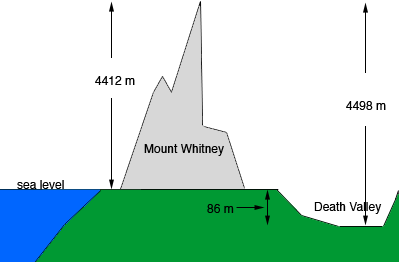Name: jennifer
Who is asking: Parent
Level of the question: Secondary
Question: I have two word problems I am trying to help my daughter but I don't get them either.
1. Every other person on a school's parent advisory committee is surveyed to determine how many people support passage of a school bond to build a new elementary school. Is this a good sample? Why or why not?
2.What is the difference in elevation between the highest point in California,Mount Whitney,which towers 4421 meters above sea level, the lowest point in California,Death Valley, which lies 86 meters below sea level?
Hi Jennifer,
I want to start with the second question. Suppose that the question were to find the difference in elevation between Mount Whitney, at 4421 meters above sea level, and North Beach California which is 26 meters above sea level? The answer is
4421 - 26 = 4395 meters.
If you now imagine Mount Whitney and Death Valley, as in the diagram,

then it is clear that if you at the bottom of Death Valley then the peak of Mount Whitney is 4498 meters above you. If you calculate this arithmetically as I did in the case of Mount Whitney and North Beach you have
4412 - (-86) = 4412 + 86 = 4498 meters.
I think the reason for asking this question is just to give an example of the fact that for any number a and b,
a - (-b) = a + b.
I am not sure I understand what is wanted in the first question. "Every other person" implies that the school's parent advisory committee is ordered in some way and you select every other one. Are they sitting around a table and you select every other on in the seating order? Do you have an alphabetic list and you select every other one? In either case the sample is influenced by the order and this is not a random sampling technique. When statisticians attempt to learn what people think about a particular issue by using a sample, the sample needs to be selected using some random sampling technique in order that probability theory can be used to make a statement about the accuracy of the prediction they make.
Another reason that the technique in the problem bothers me is the phrase "to determine how many people support passage of a school bond". Does "people" here refer to all the taxpayers or only the advisory board? If "people" means all taxpayers then the sample should be selected from all taxpayers.
Harley


